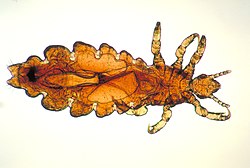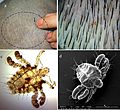Pediculosis

Editor-In-Chief: Prab R Tumpati, MD
Obesity, Sleep & Internal medicine
Founder, WikiMD Wellnesspedia &
W8MD medical weight loss NYC and sleep center NYC
| Pediculosis | |
|---|---|

| |
| Synonyms | Lice infestation |
| Pronounce | N/A |
| Specialty | N/A |
| Symptoms | Itching, visible lice or nits |
| Complications | Secondary bacterial infection |
| Onset | |
| Duration | |
| Types | N/A |
| Causes | Infestation by Pediculus humanus capitis, Pediculus humanus corporis, or Pthirus pubis |
| Risks | Close contact, sharing personal items |
| Diagnosis | Visual inspection, use of a fine-toothed comb |
| Differential diagnosis | Dandruff, seborrheic dermatitis, scabies |
| Prevention | Avoiding head-to-head contact, not sharing personal items |
| Treatment | Topical insecticides, wet combing |
| Medication | Permethrin, Ivermectin, Malathion |
| Prognosis | Good with treatment |
| Frequency | Common worldwide |
| Deaths | N/A |
Pediculosis is a condition caused by infestations of the human louse. It is a common issue worldwide, affecting millions of people each year. There are three types of lice that infest humans: head lice, body lice, and pubic lice.
Types of Pediculosis[edit]
Head Lice[edit]
Head lice (Pediculus humanus capitis) are the most common type of lice infestation. They are most commonly found in children, but can affect people of all ages. Head lice infestations are not related to personal hygiene.
Body Lice[edit]
Body lice (Pediculus humanus corporis) are less common than head lice, but can still cause significant discomfort. They are often associated with poor hygiene and living conditions, and can spread diseases such as typhus.
Pubic Lice[edit]
Pubic lice (Pthirus pubis), also known as crabs, are another type of lice infestation. They are most commonly spread through sexual contact, but can also be spread through sharing bedding or clothing.
Symptoms[edit]
The main symptom of pediculosis is itching, caused by an allergic reaction to louse saliva. Other symptoms can include a rash, sores from scratching, and the presence of lice or nits (lice eggs) in the hair or on the body.
Treatment[edit]
Treatment for pediculosis typically involves the use of over-the-counter or prescription medications that kill lice and their eggs. In some cases, manual removal of lice and nits may be necessary.
Prevention[edit]
Prevention of pediculosis involves avoiding close contact with individuals who have lice, not sharing personal items such as hats or hairbrushes, and regular cleaning of bedding and clothing.
Gallery[edit]
-
Head louse crawling on hairbrush
-
Pediculus humanus capitis
Ad. Transform your life with W8MD's Budget GLP-1 injections from $75


W8MD offers a medical weight loss program to lose weight in Philadelphia. Our physician-supervised medical weight loss provides:
- Weight loss injections in NYC (generic and brand names):
- Zepbound / Mounjaro, Wegovy / Ozempic, Saxenda
- Most insurances accepted or discounted self-pay rates. We will obtain insurance prior authorizations if needed.
- Generic GLP1 weight loss injections from $75 for the starting dose.
- Also offer prescription weight loss medications including Phentermine, Qsymia, Diethylpropion, Contrave etc.
NYC weight loss doctor appointmentsNYC weight loss doctor appointments
Start your NYC weight loss journey today at our NYC medical weight loss and Philadelphia medical weight loss clinics.
- Call 718-946-5500 to lose weight in NYC or for medical weight loss in Philadelphia 215-676-2334.
- Tags:NYC medical weight loss, Philadelphia lose weight Zepbound NYC, Budget GLP1 weight loss injections, Wegovy Philadelphia, Wegovy NYC, Philadelphia medical weight loss, Brookly weight loss and Wegovy NYC
|
WikiMD's Wellness Encyclopedia |
| Let Food Be Thy Medicine Medicine Thy Food - Hippocrates |
Medical Disclaimer: WikiMD is not a substitute for professional medical advice. The information on WikiMD is provided as an information resource only, may be incorrect, outdated or misleading, and is not to be used or relied on for any diagnostic or treatment purposes. Please consult your health care provider before making any healthcare decisions or for guidance about a specific medical condition. WikiMD expressly disclaims responsibility, and shall have no liability, for any damages, loss, injury, or liability whatsoever suffered as a result of your reliance on the information contained in this site. By visiting this site you agree to the foregoing terms and conditions, which may from time to time be changed or supplemented by WikiMD. If you do not agree to the foregoing terms and conditions, you should not enter or use this site. See full disclaimer.
Credits:Most images are courtesy of Wikimedia commons, and templates, categories Wikipedia, licensed under CC BY SA or similar.
Translate this page: - East Asian
中文,
日本,
한국어,
South Asian
हिन्दी,
தமிழ்,
తెలుగు,
Urdu,
ಕನ್ನಡ,
Southeast Asian
Indonesian,
Vietnamese,
Thai,
မြန်မာဘာသာ,
বাংলা
European
español,
Deutsch,
français,
Greek,
português do Brasil,
polski,
română,
русский,
Nederlands,
norsk,
svenska,
suomi,
Italian
Middle Eastern & African
عربى,
Turkish,
Persian,
Hebrew,
Afrikaans,
isiZulu,
Kiswahili,
Other
Bulgarian,
Hungarian,
Czech,
Swedish,
മലയാളം,
मराठी,
ਪੰਜਾਬੀ,
ગુજરાતી,
Portuguese,
Ukrainian



